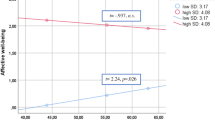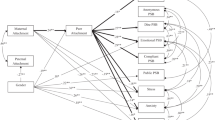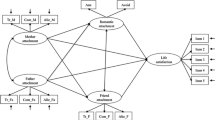Abstract
This study examined adolescents' attachments to mother and father and their associations with personality and social relations. College students (N=112) and their friends (N=90) participated. The students completed questionnaires measuring attachments to parents, loneliness, and friendship. Students also completed interaction logs for one week. The students' friends completed a friendship questionnaire and a personality description of the student. Qualities of mother-child and father-child attachment were significantly related to reports of loneliness but not friendship quality. Attachment to mother was related to the quantity and quality of daily interactions, whereas father-child attachment was related to interaction quality only. Relations between attachment and personality were moderated by sex. For men, strong associations emerged between father-child attachment and friends' personality descriptions. For women, associations between parent-child attachment and personality were contrary to prediction. The findings suggest it may be fruitful to examine adolescent's attachments to specific attachment figures.
Similar content being viewed by others
References
Armsden, G. C., and Greenberg, M. T. (1987). The Inventory of Parent and Peer Attachment: Individual differences and their relationship to psychological well-being in adolescence.J. Youth Adolesc. 16: 427–454.
Bartholomew, K., and Horowitz, L. M. (1991). Attachment styles among adults: A test of a four-category model.J. Personal. Social Psychol. 61: 226–244.
Block, J. (1971).Lives Through Time. Bancroft, Berkeley, CA.
Block, J. H., and Block, J. (1980). The role of ego-control and ego-resiliency in the organization of behavior. In Collins, W. A. (ed.),Minnesota Symposia on Child Psychology (vol. 13). Erlbaum, Hillsdale, NJ.
Bowlby, J. (1982).Attachment and Loss: Vol. 1. Attachment. Basic Books, New York.
Bowlby, J. (1973).Attachment and Loss: Vol. 2. Separation: Anxiety and Anger. Basic Books, New York.
Bowlby, J. (1979).The Making and Breaking of Affectional Bonds. Tavistock, New York.
Bowlby, J. (1989). The role of attachment in personality development and psychopathology. In Greenspan, S. I., and Pollack, G. H. (eds.),The Course of Life (Vol. 1, Infancy). International Universities Press.
Cohn, D. A. (1990). Child-mother attachment in six-year-olds and social competence at school.Child Develop. 61: 152–162.
Cohn, D. A., Patterson, C. J., and Christopoulos, C. (1991). The family and children's peer relations.J. Social Pers. Relat. 8: 315–346.
Collins, N. L., and Read, S. J. (1990). Adult attachment, working models, and relationship quality in dating couples.J. Personal. Social Psychol. 58: 644–663.
Elicker, J., Englund, M., and Sroufe, L. A. (1992). Predicting peer competence and peer relationships in childhood from early parent-child relationships. In Parke, R., and Ladd, G. (eds.),Family-Peer Relationships: Modes of Linkage. Erlbaum, Hillsdale, NJ.
Feeney, J. A., and Noller, P. (1990), Attachment style as a predictor of adult romantic relationships.J. Personal. Social Psychol. 58: 281–291.
Furman, W., and Buhrmester, D. (1985). Children's perceptions of the personal relationships in their social networks.Develop. Psychol 21: 1016–1024.
Greenberg, M. T., Siegel, J. M., and Leitch, C. J. (1983). The nature and importance of attachment relationships to parents and peers during adolescence.J. Youth Adolesc. 12: 373–386.
Greenberg, M. T., and Speltz, M. L. (1988). Attachment and the ontogeny of conduct problems. In Belsky, J., and Nezworski, T. (eds.),Clinical Implications of Attachment. Erlbaum, Hillsdale, NJ.
Hazan, C., and Shaver, P. (1987). Romantic love conceptualized as an attachment process.J. Personal. Social Psychol. 52: 511–524.
Kerns, K. A. (1994). A longitudinal examination of links between mother-child attachment and children's friendships in early childhood.J. Social Pers. Relat. 11: 379–381.
Kerns, K. A. (1996). Individual differences in friendship quality: Links to child-mother attachment. In Bukowski, W. M., Newcomb, A. F., and Hartup, W. W. (eds.),The Company They Keep: Friendship in Childhood and Adolescence. Cambridge University Press, New York.
Kerns, K. A., and Barth, J. M. (1995). Attachment and play: Convergence across components of parent-child relationships and their relations to peer relations.J. Social Pers. Relat. 12: 243–260.
Kobak, R. R., and Hazan, C. (1991). Attachment in marriage: Effects of security and accuracy of working models.J. Personal. Social Psychol. 60: 861–869.
Kobak, R. R., Cole, H. E., Ferenz-Gillies, R., Fleming, W. S., and Gamble, W. (1993). Attachment and emotion regulation during mother-teen problem solving: A control theory analysis.Child Develop. 6: 231–245.
Kobak, R. R., and Sceery, A. (1988). Attachment in late adolescence: Working models, affect regulation, and representations of self and other.Child Develop. 59: 135–146.
LaFreniere, P., and Sroufe, L. A. (1985). Profiles of peer competence in the preschool: Interrelations between measures, influence of social ecology, and relation to attachment history.Develop. Psychol. 21: 56–68.
Lewis, M., Feiring, C., McGuffog, C., and Jaskir, J. (1984). Predicting psychopathology in six-year-olds from early social relations.Child Develop. 55: 123–136.
Main, M., Kaplan, N., and Cassidy, J. (1985). Security in infancy, childhood, and adulthood: A move to the level of representation. In Bretherton, I., and Waters, E. (eds.),Monogr. SRCD, 50 (Serial No. 209).
Main, M., and Weston, D. R. (1981). The quality of the toddler's relationship to mother and to father: Related to conflict behavior and the readiness to establish new relationships.Child Develop. 52: 932–940.
Mikulincer, M., and Nachshon, O. (1991). Attachment styles and patterns of self-disclosure.J. Personal. Social Psychol. 61: 321–331.
Nezlek, J. B., Wheeler, L., and Reis, H. T. (1983). Studies of social participation. In Reis, H. T. (ed.),Naturalistic Approaches to Studying Social Interaction, New Directions for Methodology of Social and Behavioral Science (Vol. 15). Jossey-Bass, San Francisco.
Park, K. A., and Waters, E. (1989). Security of attachment and preschool friendships.Child Develop. 60: 1076–1081.
Paterson, J. E., Field, J., and Pryor, J. (1994). Adolescents' perceptions of their relationships with their mothers, fathers, and friends.J. Youth Adolesc. 23: 579–600.
Reis, H. T., and Wheeler, L. (1991). Studying social interaction with the Rochester Interaction Record.Adv. Exp. Social Psychol. 25: 269–318.
Renken, B., Egeland, B., Marvinney, D., Mangelsdorf, S., and Sroufe, L. A. (1989). Early childhood antecedents of aggression and passive-withdrawal in early elementary school.J. Personal. 57: 257–281.
Russell, D., Peplau, L. A., and Cutrona, C. E. (1980). The revised UCLA loneliness scale: Concurrent and discriminant validity evidence.J. Personal. Social Psychol. 39: 72–80.
Simpson, J. A. (1990). Influence of attachment styles on romantic relationships.J. Personal. Social Psychol. 59: 971–980.
Simpson, J. A., Rholes, W. S., and Nelligan, J. S. (1992). Seeking support and support giving within couples in an anxiety-provoking situation: The role of attachment styles.J. Personal. Social Psychol. 62: 434–446.
Sroufe, L. A. (1983). Infant-caregiver attachment and patterns of adaptation in preschool: The roots of maladaptation and competence. In Perlmutter, M. (ed.),Minnesota Symposia on Child Psychology (vol. 16). Erlbaum, Hillsdale, NJ.
Sroufe, L. A., Egeland, B., and Kreutzer, T. (1990). The fate of early experience following developmental change: Longitudinal approaches to individual adaptation in childhood.Child Develop. 61: 1363–1373.
Sroufe, L. A., and Fleeson, J. (1986). Attachment and the construction of relationships. In Hartup, W. W., and Rubin, Z. (eds.),Relationships and Development. Erlbaum, Hillsdale, NJ.
Sroufe, L. A., Fox, N. E., and Pancake, V. R. (1983). Attachment and dependency in developmental perspective.Child Develop. 5: 1615–1627.
Sroufe, L. A., and Waters, E. (1977). Attachment as an organizational construct.Child Develop. 8: 1184–1199.
Suess, G. J., Grossmann, K. E., and Sroufe, L. A. (1992). Effects of infant attachment to mother and father on quality of adaptation in preschool: From dyadic to individual organization of self.Int. J. Behav. Develop. 15: 43–66.
Troy, M., and Sroufe, L. A. (1987). Victimization among preschoolers: Role of attachment history.Am. Acad. Child Adoles. Psychiat. 26: 166–172.
Waters, E., Wippman, J., and Sroufe, L. A. (1979). Attachment, positive affect, and competence in the peer group: Two studies in construct validation.Child Develop. 50: 821–829.
Wheeler, L., Reis, H. T., and Bond, M. H. (1989). Collectivism-individualism in everyday social life: The middle kingdom and the melting pot.J. Personal. Social Psychol. 57: 79–86.
Wheeler, L., Reis, H., and Nezlek, J. (1983). Loneliness, social interaction, and sex roles.J. Personal. Social Psychol. 5: 943–953.
Youngblade, L. M., and Belsky, J. (1992). Parent-child antecedents of 5-year-olds' close friendships: A longitudinal analysis.Develop. Psychol. 28: 700–713.
Youngblade, L. M., Park, K. A., and Belsky, J. (1993). Measurement of young children's close friendship: A comparison of 2 independent assessment systems and their associations with attachment security.Int. J. Behav. Develop. 16: 563–587.
Author information
Authors and Affiliations
Additional information
This study was funded by a grant from the Kent State University Research Council.
Received Ph.D. in developmental psychology from State University of New York at Stony Brook. Research interests are children's social development, particularly the role of relationships with parents and peers.
Received master's degree in experimental psychology from Kent State University. She is now employed in the field of education.
Rights and permissions
About this article
Cite this article
Kerns, K.A., Stevens, A.C. Parent-child attachment in late adolescence: Links to social relations and personality. J Youth Adolescence 25, 323–342 (1996). https://doi.org/10.1007/BF01537388
Received:
Accepted:
Issue Date:
DOI: https://doi.org/10.1007/BF01537388




